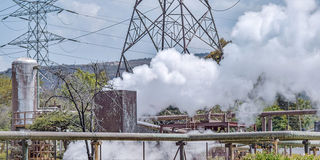State of Energy: Kenya gains regional recognition for its mix of strategies to increase power supply
Sponsored content

Steam venting at a geothermal power generation plant in Olkaria, Kenya.
By Evans Ongwae
Kenya has made massive strides in its effort to provide access to power to its more than 47 million people. It has registered much of this progress over the last eight years, thanks to various policy reforms and increased investments in energy.
Today, the country’s power sector ranks among the most developed in sub-Saharan Africa.
As the Energy Investments Infrastructure in East Africa report by the East African Energy Charter notes, “Over the last decade, the energy sector in Kenya has seen multiple rounds of sector reforms in the form of legislation and the implementation of its various national strategies.”
However, rapid population growth and the quest for fast industrialisation mean that the country has to further expand its capacity to meet rising demand.
Kenya aims to attain the middle-income status by 2030, by industrialising. That quest can only be realised if the country increases its energy consumption.
Former UN Secretary General Ban Ki-moon once said: “Energy is the golden thread that connects economic growth, increases social equity, and provides an environment that allows the world to thrive.”
He added: “Widespread energy poverty condemns billions to darkness, to ill health, to missed opportunities. Energy poverty is a threat to the achievement of the Millennium Development Goals (read Sustainable Development goals today).”
Kenya has done well in exploiting its mix of hydropower, thermal, geothermal and wind energy. It is also among standout African countries with a focus on renewable energy. The other countries are Angola, Sierra Leone, South Africa and Uganda.
The Rural Electrification and Renewable Energy Corporation (REREC) continues to make a positive difference in increasing energy access in the country.
It is also worth noting that Kenya is among the world’s most active regions for geothermal development. This was brought home with the commissioning of the 280MW geothermal project in Olkaria. Geothermal now accounts for more than 40 percent of the electricity consumed by Kenyans. The Olkaria project is also important for electricity trade among the East African countries as they also seek to exploit their geothermal resources. KenGen is sharing its skills, expertise and experiences.
Kenya is also exploring the possibility of using nuclear power to meet its growing energy demand. The Ministry of Energy and Petroleum has noted the potential use of nuclear energy for power generation. Consequently, it established the Nuclear Power and Energy Agency (NUPEA) and charged it with the responsibility of promoting and implementing Kenya’s Nuclear Power Programme.
Also, the Kenya Electricity Transmission Company Limited (KETRACO) is implementing several projects with an aim of facilitating regional grid integration. These projects are enabling the region to share or tap the competitively generated energy and meet the rising demand created by activities aimed at transforming the economies.
Read more about what the various public energy agencies in Kenya are doing to boost power supply in the region, from the following downloadable PDF.


